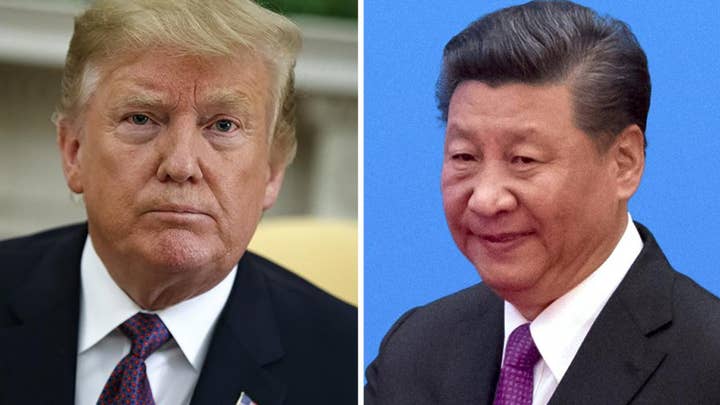Trade tensions with China drag stocks down for fourth week in a row
Stocks with exposure to China drop; FBN's Susan Li reports.
It’s easy to connect the dots when you just pick the dots you want to connect. If you want to actually distinguish truth from noise, though, that practice might not be much help.
Nowhere is this truism more true that figuring out the next steps in President Trump’s policy toward China.
Figuring out what Trump is up to is a big deal. It’s a big deal for American companies trying to decide how to align their future supply chains. It’s a huge question for America’s friends and allies, particularly in the Indo-Pacific and Europe, who are afraid Trump will seal an agreement that will leave them hanging.
JAMES CARAFANO: TRUMP'S STYLE LACKS POLISH, BUT HIS STATECRAFT IS SOUND
Here is my best advice. Don’t waste your time dot-connecting.
When it comes to China, Trump has done anything but paint a clear picture. Trump-diviners just got another lesson in that.
The White House recently issued an executive order banning suspect technologies from the U.S., a directive aimed at Huawei and other Chinese telecom companies. Separately, the administration also banned Huawei specifically from buying U.S. technology, the full impact of which was later delayed for 90 days.
Policy experts have trotted out all kinds of interpretations. One view argues the delay represents the U.S. yielding to pushback organized by China. Another holds that the president is just using the whole issue as a bargaining chip in the trade talks. The Commerce Department continues to maintain that the ban is serious.
Depending on whose dot-connecting you like, you can draw very different conclusions on what Trump is up to. But rather than guessing who guessed right, better to start with what we know than guessing about what we don’t.
1. Never expect the administration’s relations with China to follow a straight line. Before Trump, the plan was to avoid confrontation with Beijing. In fact, the U.S. tried to avoid contentious issues altogether. Trump turned that approach on its head, conspicuously looking to confront the Chinese economically, diplomatically and militarily, forcing them to respect America’s interests.
The administration knows this strategy will have to play out over time rather than end in a showdown at the OK Corral. There will be some pushing and shoving on both sides, ups and downs, name-calling and back-slapping. The White House knows it’s riding a geo-political rollercoaster. So should we.
2. There is no grand bargain. Long before there was Trump, there was talk of a G2, a big deal between the governments in Beijing and Washington that would divide up the world and tell everyone else what to do. That was a fear that was unfounded then. Nothing has changed. The two sides might make nice now and then, as when Obama and Xi reached an agreement on cyber-espionage in 2015, but that’s just a pause in the action. The new normal is don’t expect there to be a normal – for long, anyway.
3. Don’t think Trump needs a deal. There is a notion that the White House in the end will be desperate for deals, any deal, because the president needs one to burnish his chances of re-election. Don’t bet on it. With a strong economy at his back and bipartisan support to be “tough on China,” the administration not only might not be desperate for a deal, it could well conclude it’s happy to wait until after the election when the White House might feel it can negotiate from an even stronger position. There might be a deal. There might not be.
4. Trump has cards to play. Beijing is not the irresistible economic juggernaut that many often assume. For example, cutting off Chinese ICT manufacturer ZTE from American products, even though the prohibition was brief, threatened to destroy the Chinese giant. Trump also showed that supply chain dependencies are not a one-way street, with China holding the reins of the chains. The White House also has shown that global supply chains aren’t fixed. There are other options. Expect Trump, and American companies, to consider them.
CLICK HERE TO GET THE FOX NEWS APP
5. Don’t lose sight of Trump’s policies. His rhetoric may be loose; his use of tariffs questionable; even his interpretation of free-market economics may be a bit sketchy. That said, in the end, Trump’s policies often look far more traditional in practice than many assume. The U.S. hasn't become isolationist. It hasn’t abandoned its values or its friends. It hasn’t devolved into a managed economy of state-owned enterprises. Don’t expect America to stop being America.
So let’s remember as we debate the great questions (Will there be a trade deal? Will Huawei be ultimately dispatched by Trump to the global doghouse? And whither tariffs?) that however entertaining it may be to speculate, we shouldn’t bet the house on anyone’s ability to connect dots. Zigs when we expect zags should surprise no one.


